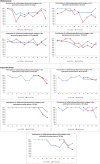Fidelity evaluation of the compared procedures for conducting the PVS-PREDIAPS implementation strategy to optimize diabetes prevention in primary care
- PMID: 33573600
- PMCID: PMC7879624
- DOI: 10.1186/s12875-021-01378-z
Fidelity evaluation of the compared procedures for conducting the PVS-PREDIAPS implementation strategy to optimize diabetes prevention in primary care
Abstract
Background: Assessing the fidelity of an implementation strategy is important to understand why and how the strategy influences the uptake of evidence-based interventions. The present study aims to assess the fidelity of the two procedures for engaging primary care (PC) professionals and for the deployment of an implementation strategy for optimizing type 2 diabetes prevention in routine PC within the PREDIAPS randomized cluster implementation trial.
Method: We conducted a mixed-method fidelity evaluation study of the PVS-PREDIAPS implementation strategy. Nine PC centers from the Basque Health Service (Osakidetza) were allocated to two different procedures to engage physicians and nurses and deploy a implementation strategy to model and adapt the clinical intervention and its implementation to their specific contexts: a Global procedure, promoting the cooperation of all healthcare professionals from the beginning; or a Sequential procedure, centered first on nurses who then pursued the pragmatic cooperation of physicians. Process indicators of the delivery and receipt of implementation strategy actions, documented modifications to the planned implementation strategy, and a structured group interview with centers' leaders were all used to assess the following components of fidelity: adherence, dose, quality of delivery, professionals' responsiveness and program differentiation.
Results: Generally, the procedures compared for professionals engagement and deployment of the implementation strategy were carried out with the planned differentiation. Nonetheless, some unexpected between-group differences were observed, the initial rate of collaboration of nurses being higher in the Sequential (93%) than in the Global (67%) groups. Exposure rate to the programed implementation actions (% of hours received out of those delivered) were similar in both groups by professional category, with nurses (86%) having a higher rate of exposure than physicians (75%). Professionals identified half of the planned discrete strategies and their rating of strategies' perceived usefulness was overwhelmingly positive, with few differences between Sequential and Global centers.
Conclusions: The PVS-PREDIAPS implementation strategy has been implemented with high fidelity and minor unplanned reactive modifications. Professionals' exposure to the implementation strategy was high in both groups. The centers' organizational context (i.e., work overload) led to small mismatches between groups in participation and exposure of professionals to implementation actions.
Trial registration: Clinicaltrials.gov identifier: NCT03254979 . Registered 16 August 2017.
Keywords: Diabetes prevention; Fidelity; Implementation strategy; Primary healthcare.
Conflict of interest statement
The authors declare that they have no competing interests.
Figures
References
-
- Dusenbury L, Brannigan R, Falco M, Hansen WB. A review of research on fidelity of implementation: implications for drug abuse prevention in school settings. Health Educ Res. 2003;18:237–256. 2. - PubMed
Publication types
MeSH terms
Associated data
Grants and funding
LinkOut - more resources
Full Text Sources
Other Literature Sources
Medical
Research Materials


